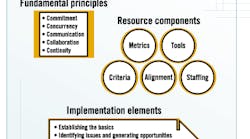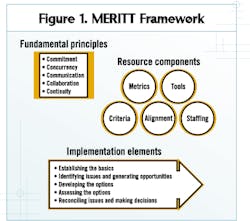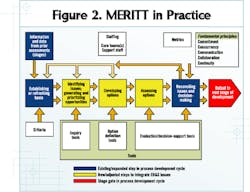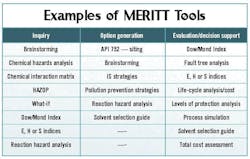Some of the typical modifications that might be needed for existing processes include: The identification of minimum expectations for the involvement of EH&S expertise and reviews (i.e., applications of tools) at different stages, just as some level of cost estimate typically is required at most stages. Overview training on MERITT concepts as part of any formal or informal project management training. Specific training on MERITT tools and guidance on the means to obtain additional information, whether it is through internal resources or external Web sites, also is needed. Publication of a listing or directory of MERITT contacts and resources to assist project managers and other team members. Incorporation of MERITT-related metrics into the project management metrics and tracking system. This also will serve to reinforce the value to the engineers and scientists who are involved.Staffing and knowledge issuesIt is crucial that the right types of information, expertise and knowledge are brought to bear at the right times in the process. Availability and utilization of staff are critical in this regard. This is where the corporate and project organizational interfaces can either collide or meld. Tailoring the "who," "when," and "how" in staffing for the development process is not an insignificant task. It cuts into the territorial and cultural barriers of different organizations. In addition, such decisions also must work with the existing process development systems, assuming they are functioning properly.Traditionally, EH&S expertise is added relatively late in the process. The addition of this expertise earlier is not always feasible or desirable; therefore, other means of knowledge transfer must be included to support EH&S integration. The goal is to allow knowledge transfer to occur in a way that does not overly encumber the development process with masses of people and frequent, lengthy meetings. The complement of disciplines, experts, leaders and facilitators/coordinators involved at each step along the way, therefore, should be choreographed carefully in advance and adjusted as needed throughout the process. The same is true for the manner in which the communications and interchanges are to occur ," whether that involves meetings, teleconferences and/or other types of exchanges.Tools that bring the critical EH&S knowledge to the process development team without requiring EH&S "bodies" can be very effective. Unless the projects are very small and short-lived, some degree of structure within the project team inevitably will be required. This can be accomplished through the use of both core teams and support groups (such as environmental, health or safety specialists) in terms of staff utilization. However, traditional staffing will need to be expanded both horizontally and vertically. This includes the use of staff to accomplish better transitions between stages, effectively actualizing the five fundamental principles.ToolsDozens of tools have been developed to assist in EH&S evaluations. Roughly two dozen have been identified for potential use in supporting MERITT. These have been drawn from several sources, notably: Existing environmental, health and/or safety paradigms such as pollution prevention, green chemistry, inherent safety and design for the environment. Recent efforts in developing integrated EH&S tools. Codified process safety tools such as process hazard analyses. Widely used business analysis methodologies such as life-cycle analysis. Decision theory.These tools are grouped into three general categories for MERITT: inquiry, option generation and option evaluation/ decision support. Inquiry tools primarily are intended to identify EH&S issues and offer less help with immediate solutions. As their name implies, option generation tools help in the formulation of alternative-design concepts to address issues found with inquiry tools. Evaluation or decision-support tools focus on methods for ranking alternatives using various EH&S and cost criteria. The results typically are expressed in the form of indices or numerical rankings. The table provides examples for each category. These tools provide one way to capture EH&S knowledge and transfer it to others.





